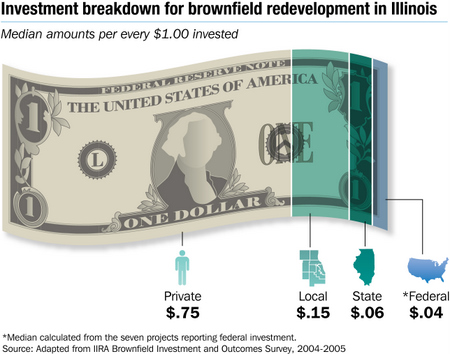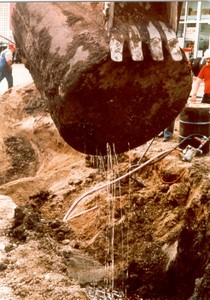The benefits of brownfield remediation and redevelopment extend beyond removal of contaminants, in that it brings a site back to active use – returning it to the tax rolls, leveraging private investment, and creating businesses and jobs.
Funds Leveraged
State and local governments have joined the private sector in paying much more attention to outcomes and outputs of public investment, and efforts have been taken to measure the economic impacts of brownfield redevelopment. Some economic impact performance measures for brownfields redevelopment include the number of jobs created, the number of businesses created, the amount of private sector funding leveraged, or the tax revenues added. In a study focused on the state of Illinois, a detailed analysis of 37 brownfield redevelopment projects was done, attempting to quantify all of these measures. It investigated how projects were funded, and how various public (federal, state, or local) funds were leveraged to entice private investment (IIRA 2005).

The graphic portrays how, according to the IIRA study, most investment in brownfield projects is from the private sector ($.75 of every dollar). However, it is important to note that many projects are initially funded through public investment, which is often used to leverage this private investment. The study found median private investments upwards of eight times the initial public investment, depending on whether it was federal, state, or locally funded (IIRA 2005).
It is important to quantify how public funding leverages private funding, because brownfield redevelopment is essentially a private sector project, and communities may question its appropriateness. Furthermore, it is important to note how the ratio of public to private funding is highly dependant on the stage of the project. "For example, state investment often involves assessment costs early in a project and may represent a relatively high investment compared with the overall project cost. This is especially true in projects with serious contamination" (IIRA 2005). Initial public investment, although seemingly expensive at the time, can trigger major private investments in the long-term, thereby creating an economically viable opportunity. These ratios, and how they change over the life the project, are affected by how much is known about the contamination, whether the municipality purchased the property, and whether it tried to recover the initial investment in property.
The study found, that in Illinois, the investments by the public sector brought substantial returns, especially at the state level—a median return of $16 in total investment per $1 of state investment in the brownfield program. "While state investment does not necessarily cause private investment, the external funding can help the local government provide a productive economic environment suitable for business investment, thus representing a successful public-private partnership" (IIRA 2005).
Job Creation
In addition to the amount of private and total investment, many brownfield projects also serve to create new businesses and jobs. IIRA's survey found that an average of 66 full-time equivalent jobs was created per brownfield redevelopment project (IIRA 2005). In addition, a national survey found that of the 72 cities that responded, approximately 83,171 jobs were created due to brownfield redevelopment (21,977 pre-development/construction jobs; 61,194 post-development/permanent jobs) (US Conference of Mayors, 2006). According to the City of Chicago, their Brownfields Initiative has resulted in more than 3,000 new jobs (Graham conversation, 2008).
Oftentimes, these jobs are created in neighborhoods where they are most needed. The US EPA has recognized the import of job creation in brownfield redevelopment and has initiated a grant program to support job training for environmental remediation and redevelopment in communities with numerous brownfields.
Tax Revenues
Brownfield sites are often abandoned and vacant and therefore not producing tax revenues for the municipalities and other taxing jurisdictions. This loss of earnings potential is in addition to the other strains on the economic health of the neighborhood outlined below, making brownfields even more detrimental to a community. According to a national survey, 79% of respondents stated that increasing the municipality's tax base was a primary benefit of brownfield redevelopment. From the survey, 64 respondent communities determined that local tax revenues generated from redeveloped brownfield sites totaled $233 million (US Conference of Mayors, 2006). The City of Chicago estimates that their Brownfields Initiative has increased the City's tax base by more than $1 million annually (Graham conversation, 2008). Returning these abandoned sites to active use not only creates jobs and investment, but increases a community's tax revenue.
Ripple Effect
When done well, a redevelopment project can prompt a series of investments in nearby properties and therefore extend the benefits to a wider area (Chilton 1998; Meyer 1998). The jobs and investments created because of brownfield redevelopment include only those that were direct effects, but these investments also cause a ripple effect throughout the local economy. One recent example found that the effects of brownfield redevelopment had a total output multiplier of 3.8, meaning that an additional $1 generated because of the brownfield project is likely to lead to $3.80 in total investment (NRTEE 2003).
Other Benefits
In addition to quantifiable measures like tax revenues, job creation, and funding leveraged, anecdotal evidence points to the economic impacts of brownfields as well. For example, a frequent goal of brownfields programs is to bring new resources and previously unavailable products and services to the communities in which they are located – such as a needed grocery store, drug store, health clinic or other amenity. Expansion of existing businesses or investment by new businesses, the slowing or reversing of economic decline, the increased earnings of surrounding businesses are also all indicators of success (ICMA 2002).
Local Case Studies of Fiscal Impacts
A case-study analysis of six different brownfield redevelopment projects throughout the region supports the economic impacts described above. For each brownfield development, the financial costs and benefits were measured, through the perspective of their taxing district. The six projects studied included Metra Station and Gateway Center in Palatine, State Line Industrial Area in Calumet City, Westin Hotel in Wheeling, Homan Square in Chicago, Station Crossing in Downers Grove, and Main Street Station in Roselle. (Details about this case study analysis can be found in the report done for CMAP by S.B. Friedman & Company, available online.)
The analysis identified the total cost of the projects – divided into municipal investment, state and federal grant support, and private investment. It then measured the projects' economic impacts on the site – including the change in equalized assessed value (EAV), the change in property tax generation, and any new annual sales, hotel, and/or restaurant tax generation. In addition, the analysis measured the "indirect" or "secondary" economic impacts of properties located in immediately adjacent blocks to the site, by also tracking both the change in EAV and the change in EAV compound annual growth rates for these properties.
Overall, the analysis revealed significantly positive economic impacts, both on the primary site itself as well as the secondary areas surrounding the development. The property value multiplier, a metric showing the ratio of inflation-adjusted EAV to the project site prior to construction and after completion, ranged from 1.3 to 8.3 (excluding one high outlier). The property value multiplier for the secondary areas were also mostly positive; but perhaps more significantly, the change in EAV compound annual growth rates for these neighboring properties not only grew faster than it had prior to project completion, but it also switched from declining values before the project to increasing values after the project. These increases in EAV translated into significant increases in property tax and other tax revenues for the municipalities.
These case-studies also highlighted how imperative it is to couple brownfield redevelopment with good planning. Factors such as the density of redevelopment, the type of uses associated with the redevelopment, and understanding market viability for the project, all play a key role in ensuring economic benefits.
 Many brownfield redevelopment programs, driven by economic benefits, have been focused on returning sites back to industrial and manufacturing uses. Sites are capped, physical barriers such as pavement are put in place to prevent exposure, steps are taken to prevent usage of groundwater, and the site is returned to active use. The encapsulation of contamination is an environmental benefit – not only does it prevent exposure to humans, it can also reduce the runoff of toxics into nearby water bodies, and therefore lead to improvements in overall water quality and habitat (US EPA, 2001).
Many brownfield redevelopment programs, driven by economic benefits, have been focused on returning sites back to industrial and manufacturing uses. Sites are capped, physical barriers such as pavement are put in place to prevent exposure, steps are taken to prevent usage of groundwater, and the site is returned to active use. The encapsulation of contamination is an environmental benefit – not only does it prevent exposure to humans, it can also reduce the runoff of toxics into nearby water bodies, and therefore lead to improvements in overall water quality and habitat (US EPA, 2001).